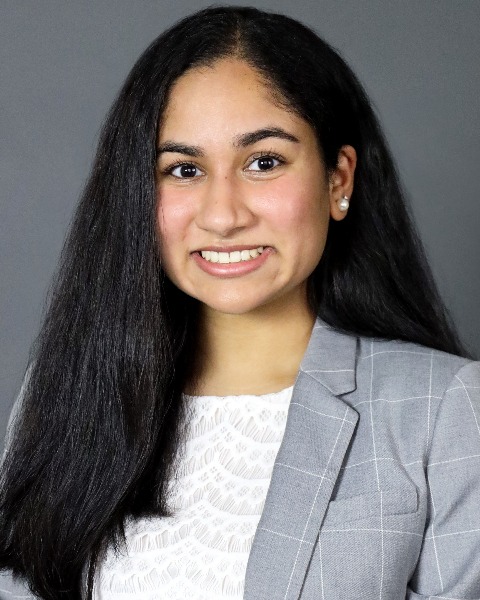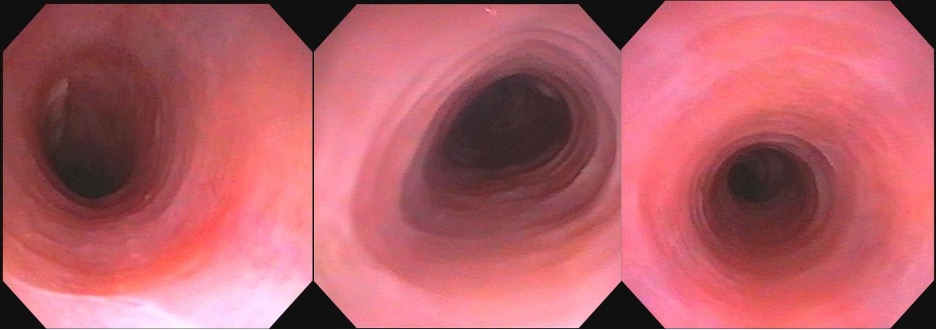Monday Poster Session
Category: Esophagus
P2851 - Unveiling the Uncommon: A Rare Case of Lymphocytic Esophagitis Manifesting as Chronic Dysphagia
Monday, October 27, 2025
10:30 AM - 4:00 PM PDT
Location: Exhibit Hall

Alekhya Mannava, MD, MBA
University Hospitals Cleveland Medical Center, Case Western Reserve University
Cleveland, OH
Presenting Author(s)
Alekhya Mannava, MD, MBA1, Sami Mesgun, MD1, Adily N. Elmi, MD, MPH1, Apoorva K. Chandar, MBBS, MPH2, Gregory S. Cooper, MD2, John A. Dumot, MD2, Amy Hosmer, MD3
1University Hospitals Cleveland Medical Center, Case Western Reserve University, Cleveland, OH; 2Digestive Health Institute, University Hospitals Cleveland Medical Center, Cleveland, OH; 3University of Pittsburgh Medical Center, Pittsburgh, PA
Introduction: Lymphocytic esophagitis (LyE) is a rare inflammatory disorder characterized by increased intraepithelial lymphocytes in the esophageal mucosa, most commonly affecting older females. Clinical symptoms often include dysphagia, chest pain, and heartburn. LyE has been associated with gastroesophageal reflux disease (GERD) and autoimmune diseases. Endoscopic findings vary widely and may resemble eosinophilic esophagitis (EoE), making diagnosis challenging. The natural history and optimal management of LyE remain poorly defined.
Case Description/
Methods: A 93-year-old female with longstanding dysphagia, GERD, and prior esophageal strictures requiring dilation presented with worsening dysphagia, poor oral intake, and weight loss. Ten years earlier, proximal esophageal biopsies at an outside hospital showed chronic inflammation and fibrosis consistent with reflux esophagitis. Initial esophagogastroduodenoscopy (EGD) at our center revealed edematous, fissured mucosa with concentric rings and loss of vascular pattern, suggestive of EoE. However, biopsies demonstrated squamous mucosa with increased intraepithelial lymphocytes and rare dyskeratotic cells, consistent with LyE. A moderate-to-severe proximal esophageal stricture at the cricopharynx was dilated. Follow-up EGDs at one and two months identified persistent intrinsic strictures, which were balloon dilated to 12.5 mm and 14 mm, respectively. The patient was treated with oral budesonide and continued her home proton pump inhibitor (PPI), resulting in symptomatic improvement. A repeat EGD was scheduled for the future to assess for potential re-dilation.
Discussion: LyE is a chronic but benign esophageal condition associated with esophageal motility disorders, medications, and immune-mediated diseases. Unlike peptic strictures, which are usually distal, proximal or multiple strictures should raise suspicion for alternative diagnoses like EoE or LyE. This case illustrates the importance of esophageal biopsies, especially when dysphagia persists or strictures occur in atypical locations. Although biopsy protocols for LyE are not standardized, sampling from mid and upper esophagus, as done for EoE, may improve diagnostic yield. Our patient's endoscopic findings mimicked EoE, but histology confirmed LyE, highlighting the diagnostic complexity of this condition. Given its variable presentation and unclear pathogenesis, further studies are necessary to establish standardized diagnostic criteria and optimal treatment strategies for LyE.

Figure: Figure 1: EGD findings of the proximal and distal esophagus revealing crepe-paper-like mucosa with concentric rings and loss of vascular pattern.

Figure: Figure 2: Esophageal biopsies showed squamous mucosa with increased intraepithelial lymphocytes and rare dyskeratotic cells at 20X (left) and 32X (right) magnification.
Disclosures:
Alekhya Mannava indicated no relevant financial relationships.
Sami Mesgun indicated no relevant financial relationships.
Adily Elmi indicated no relevant financial relationships.
Apoorva Chandar indicated no relevant financial relationships.
Gregory Cooper indicated no relevant financial relationships.
John A. Dumot indicated no relevant financial relationships.
Amy Hosmer indicated no relevant financial relationships.
Alekhya Mannava, MD, MBA1, Sami Mesgun, MD1, Adily N. Elmi, MD, MPH1, Apoorva K. Chandar, MBBS, MPH2, Gregory S. Cooper, MD2, John A. Dumot, MD2, Amy Hosmer, MD3. P2851 - Unveiling the Uncommon: A Rare Case of Lymphocytic Esophagitis Manifesting as Chronic Dysphagia, ACG 2025 Annual Scientific Meeting Abstracts. Phoenix, AZ: American College of Gastroenterology.
1University Hospitals Cleveland Medical Center, Case Western Reserve University, Cleveland, OH; 2Digestive Health Institute, University Hospitals Cleveland Medical Center, Cleveland, OH; 3University of Pittsburgh Medical Center, Pittsburgh, PA
Introduction: Lymphocytic esophagitis (LyE) is a rare inflammatory disorder characterized by increased intraepithelial lymphocytes in the esophageal mucosa, most commonly affecting older females. Clinical symptoms often include dysphagia, chest pain, and heartburn. LyE has been associated with gastroesophageal reflux disease (GERD) and autoimmune diseases. Endoscopic findings vary widely and may resemble eosinophilic esophagitis (EoE), making diagnosis challenging. The natural history and optimal management of LyE remain poorly defined.
Case Description/
Methods: A 93-year-old female with longstanding dysphagia, GERD, and prior esophageal strictures requiring dilation presented with worsening dysphagia, poor oral intake, and weight loss. Ten years earlier, proximal esophageal biopsies at an outside hospital showed chronic inflammation and fibrosis consistent with reflux esophagitis. Initial esophagogastroduodenoscopy (EGD) at our center revealed edematous, fissured mucosa with concentric rings and loss of vascular pattern, suggestive of EoE. However, biopsies demonstrated squamous mucosa with increased intraepithelial lymphocytes and rare dyskeratotic cells, consistent with LyE. A moderate-to-severe proximal esophageal stricture at the cricopharynx was dilated. Follow-up EGDs at one and two months identified persistent intrinsic strictures, which were balloon dilated to 12.5 mm and 14 mm, respectively. The patient was treated with oral budesonide and continued her home proton pump inhibitor (PPI), resulting in symptomatic improvement. A repeat EGD was scheduled for the future to assess for potential re-dilation.
Discussion: LyE is a chronic but benign esophageal condition associated with esophageal motility disorders, medications, and immune-mediated diseases. Unlike peptic strictures, which are usually distal, proximal or multiple strictures should raise suspicion for alternative diagnoses like EoE or LyE. This case illustrates the importance of esophageal biopsies, especially when dysphagia persists or strictures occur in atypical locations. Although biopsy protocols for LyE are not standardized, sampling from mid and upper esophagus, as done for EoE, may improve diagnostic yield. Our patient's endoscopic findings mimicked EoE, but histology confirmed LyE, highlighting the diagnostic complexity of this condition. Given its variable presentation and unclear pathogenesis, further studies are necessary to establish standardized diagnostic criteria and optimal treatment strategies for LyE.

Figure: Figure 1: EGD findings of the proximal and distal esophagus revealing crepe-paper-like mucosa with concentric rings and loss of vascular pattern.

Figure: Figure 2: Esophageal biopsies showed squamous mucosa with increased intraepithelial lymphocytes and rare dyskeratotic cells at 20X (left) and 32X (right) magnification.
Disclosures:
Alekhya Mannava indicated no relevant financial relationships.
Sami Mesgun indicated no relevant financial relationships.
Adily Elmi indicated no relevant financial relationships.
Apoorva Chandar indicated no relevant financial relationships.
Gregory Cooper indicated no relevant financial relationships.
John A. Dumot indicated no relevant financial relationships.
Amy Hosmer indicated no relevant financial relationships.
Alekhya Mannava, MD, MBA1, Sami Mesgun, MD1, Adily N. Elmi, MD, MPH1, Apoorva K. Chandar, MBBS, MPH2, Gregory S. Cooper, MD2, John A. Dumot, MD2, Amy Hosmer, MD3. P2851 - Unveiling the Uncommon: A Rare Case of Lymphocytic Esophagitis Manifesting as Chronic Dysphagia, ACG 2025 Annual Scientific Meeting Abstracts. Phoenix, AZ: American College of Gastroenterology.
